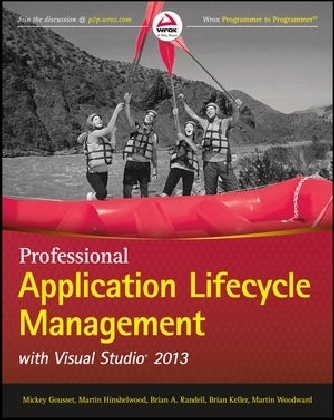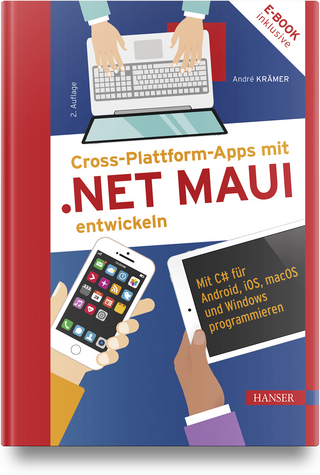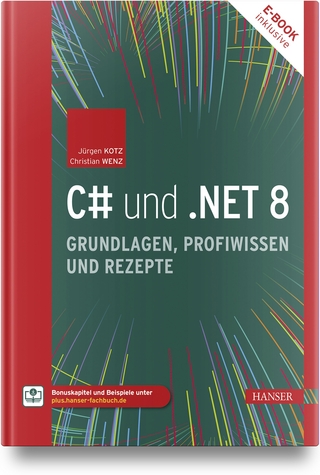
Professional Application Lifecycle Management
John Wiley & Sons (Verlag)
978-1-118-83658-3 (ISBN)
- Titel ist leider vergriffen;
keine Neuauflage - Artikel merken
Professional Application Lifecycle Management with Visual Studio 2013 provides a complete framework for using ALM to streamline software design and deployment processes using well-developed Microsoft tools and methodologies. It is your guide to make use of newly-available ALM features to take your enterprise software development to the next level.
Microsoft's Application Lifecycle Management (ALM) makes software development easier and now features support for iOS, MacOS, Android, and Java development.
If you are an application developer, some of the important factors you undoubtedly consider in selecting development frameworks and tools include agility, seamless collaboration capabilities, flexibility, and ease of use.
Microsoft's ALM suite of productivity tools includes new functionality and extensibility that are sure to grab your attention.
Professional Application Lifecycle Management with Visual Studio 2013 provides in-depth coverage of these new capabilities.
Authors Mickey Gousset, Martin Hinshelwood, Brian A. Randell, Brian Keller, and Martin Woodward are Visual Studio and ALM experts, and their hands-on approach makes adopting new ALM functionality easy.
- Streamline software design and deployment with Microsoft tools and methodologies
- Gain a practical overview of ALM with step-by-step guides and reference material
- Case studies illustrate specific functionality and provide in-depth instruction
- Use new capabilities to support iOS, MacOS, Android and Java development
- Discover this comprehensive solution for modeling, designing, and coordinating enterprise software deployments
- Over 100 pages of new content, forward-compatible with new product releases
Mickey Gousset is a Microsoft ALM MVP and Principal Consultant at Infront Consulting Group.
Martin Hinshelwood is a Microsoft ALM MVP and Principal Consultant at naked ALM Consulting.
Brian A. Randell is a Microsoft ALM MVP and Partner at MCW Technologies.
Brian Keller is a Principal Technical Evangelist for Microsoft, specializing in Visual Studio and Application Lifecycle Management.
Martin Woodward is a Principal Program Manager in the Visual Studio Application Lifecycle Management team at Microsoft and a former MVP.
INTRODUCTION xxix CHAPTER 1: INTRODUCTION TO APPLICATION LIFECYCLE MANAGEMENT WITH VISUAL STUDIO 2013 1 Application Lifecycle Management 2 Visual Studio 2013 Product Lineup 3 Application Lifecycle Management Challenges 4 Enter Visual Studio 2013 5 Application Lifecycle Management in Action 6 Requirements 6 System Design and Modeling 7 Code Generation 7 Testing 7 Feedback 8 Operations 8 Putting It into Context 8 Summary 8 PART I: TEAM FOUNDATION SERVER CHAPTER 2: INTRODUCTION TO TEAM FOUNDATION SERVER 11 What Is Team Foundation Server? 12 Acquiring Team Foundation Server 13 Hosted Team Foundation Server 13 On-Premises Installation 15 Team Foundation Server Core Concepts 15 Team Foundation Server 16 Team Project Collection 16 Team Project 17 Teams 20 Process Templates 21 Work Item Tracking 22 Version Control 23 Team Build 25 Accessing Team Foundation Server 26 Accessing Team Foundation Server from Visual Studio 27 Accessing Team Foundation Server Through a Web Browser 29 Using Team Foundation Server in Microsoft Excel 30 Using Team Foundation Server in Microsoft Project 31 Command-Line Tools for Team Foundation Server 31 Accessing Team Foundation Server from Eclipse 31 Windows Explorer Integration with Team Foundation Server 32 Access to Team Foundation Server via Other Third-Party Integrations 32 What's New in Team Foundation Server 2013 33 Version Control 33 Web Access 33 Agile Portfolio Management 33 Release Management 34 The Cloud 34 Adopting Team Foundation Server 34 Summary 36 CHAPTER 3: USING CENTRALIZED TEAM FOUNDATION VERSION CONTROL 37 Team Foundation Version Control and Visual SourceSafe (VSS) 2005 39 Setting Up Version Control 40 Using Source Control Explorer 41 Setting Up Your Workspace 42 Getting Existing Code 43 Sharing Projects in Version Control 45 Check-In Pending Changes 48 Checking In an Item 50 Creating and Administering Check-In Policies 54 Viewing History 57 Labeling Files 58 Shelving 59 Workspaces 61 Server Workspaces 64 Local Workspaces 65 Command-Line Tools 66 Branching and Merging 67 Branching Demystified 67 Common Branching Strategies 70 Summary 75 CHAPTER 4: DISTRIBUTED VERSION CONTROL WITH GIT AND TEAM FOUNDATION SERVER 77 Fundamentals of Distributed Version Control with Git 78 Getting Started with the Visual Studio Tools for Git 79 Clone 80 Commit 83 Push, Pull, and Fetch 86 Merging Changes with Git and Visual Studio 88 Branch Creation 88 Summary 91 CHAPTER 5: TEAM FOUNDATION BUILD 93 Team Foundation Build 94 What's New in Team Foundation Build 2013 95 Support for Git-based Repositories 96 Simplified Building and Testing of Windows Store Apps 97 MSTest Support Removed 99 Enhanced Hosted Build Services 99 Build Output Changes 99 Simplified Process Template 100 Built-in Support for Calling Scripts 100 Team Foundation Build Architecture 100 Working with Builds 101 Team Explorer 102 Build Explorer 102 Build Details View 103 Creating a Build Definition 104 Queuing a Build 114 Build Notifications 116 Team Build Process 118 Default Template Process 119 Build Process Parameters 119 Summary 125 CHAPTER 6: RELEASE MANAGEMENT 127 What Is Release Management? 127 Continuous Software Delivery 129 Defining a Release Pipeline 132 Configuring for First Use 133 Introduction to Actions 135 Introduction to Release Paths 137 Creating Release Templates 142 Creating Releases 148 Approvals 149 Summary 151 CHAPTER 7: COMMON TEAM FOUNDATION SERVER CUSTOMIZATIONS 153 Object Models 154 Client Object Model 155 Server Object Model 155 Build Process Object Model 155 Simple Object Model Example 155 Java SDK for TFS 157 Customizing Team Foundation Build 157 Creating Custom Build Process Templates 157 Creating Custom Build Workflow Activities 159 Customizing Team Foundation Version Control 160 Custom Check-in Policies 160 Team Foundation Server Event Service 161 Customizing Work Item Tracking 162 Modifying Work Item Type Definitions 162 Creating Custom Work Item Controls 163 Summary 163 PART II: BUILDING THE RIGHT SOFTWARE CHAPTER 8: INTRODUCTION TO BUILDING THE RIGHT SOFTWARE 167 Stakeholders 169 Storyboarding 170 Capturing Stakeholder Feedback 171 Work Item Only View 172 Third-Party Requirements Management Solutions 173 TeamCompanion 173 TeamSpec 174 inteGREAT 174 Summary 176 CHAPTER 9: STORYBOARDING 177 Why Storyboarding? 177 PowerPoint Storyboarding 179 Storyboard Shapes 180 Layouts 181 Screenshots 182 My Shapes 185 Animations 187 Hyperlinks 188 Storyboard Links 189 Summary 190 CHAPTER 10: CAPTURING STAKEHOLDER FEEDBACK 193 Requesting Feedback 194 Providing Feedback 195 Voluntary Feedback 199 Summary 199 PART III: PROJECT MANAGEMENT CHAPTER 11: INTRODUCTION TO PROJECT MANAGEMENT 203 Project Management Enhancements in Team Foundation Server 2013 204 Rich Work Item Relationships 204 Agile Planning Tools 205 Test Case Management 207 Feedback Management 207 Enhanced Reporting 208 SharePoint Server Dashboards 208 Work Items 209 Work Item Types 209 Areas and Iterations 211 Process Templates 214 MSF for Agile Software Development 215 MSF for CMMI Process Improvement 217 Visual Studio Scrum 221 Third-party Process Templates 222 Custom Process Templates 223 Managing Work Items 223 Using Visual Studio 223 Using Microsoft Excel 228 Using Microsoft Project 230 Using Team Web Access 230 Project Server Integration 231 Summary 232 CHAPTER 12: AGILE PLANNING AND TRACKING 233 Defining a Team 234 Managing Portfolio Backlogs 240 Maintaining Product Backlogs 244 Planning Iterations 248 Tracking Work 251 Customization Options 253 Summary 255 CHAPTER 13: USING REPORTS, PORTALS, AND DASHBOARDS 257 Team Foundation Server Reporting 258 Working with Team Foundation Server Reports 260 Tools to Create Reports 261 Working with Microsoft Excel Reports 262 Working with RDL Reports 273 Summary 274 PART IV: ARCHITECTURE CHAPTER 14: INTRODUCTION TO SOFTWARE ARCHITECTURE 277 Designing Visually 277 Microsoft's Modeling Strategy 279 Understanding Model-Driven Development 279 Understanding Domain-Specific Languages 280 The "Code Understanding" Experience 281 The Architecture Tools in Visual Studio Ultimate 2013 281 Use Case Diagrams 282 Activity Diagrams 283 Sequence Diagrams 283 Component Diagrams 284 Class Diagrams 284 Layer Diagrams 286 Architecture Explorer 286 What's New with Architecture Tools in Visual Studio Ultimate 2013 287 Code Maps 287 Visual Studio Visualization and Modeling SDK 288 Summary 288 CHAPTER 15: TOP-DOWN DESIGN WITH USE CASE, ACTIVITY, SEQUENCE, COMPONENT, AND CLASS DIAGRAMS 289 Use Case Diagrams 290 Creating a Use Case Diagram 290 Use Case Diagram Toolbox 294 Activity Diagrams 295 Creating an Activity Diagram 295 Activity Diagram Toolbox 298 Adding an Activity Diagram to a Use Case Diagram 300 Sequence Diagrams 300 Creating a Sequence Diagram 300 Sequence Diagram Toolbox 303 Component Diagrams 304 Creating a Component Diagram 304 Component Diagram Toolbox 308 Class Diagrams 310 Creating a Class Diagram 311 Class Diagram Toolbox 312 Generating Code from a UML Class Diagram 314 Summary 315 CHAPTER 16: ANALYZING APPLICATIONS USING ARCHITECTURE EXPLORER, DEPENDENCY GRAPHS, AND CODE MAPS 317 Understanding the Code Base 318 Architecture Explorer Basics 319 Understanding the Architecture Explorer Window 320 Architecture Explorer Options 320 Navigating Through Architecture Explorer 321 Exploring Options for Namespaces 323 Exploring Options for Classes 325 Exploring Options for Members 326 Dependency Graphs 328 Creating the First Dependency Graph 328 Creating a Dependency Graph Without Architecture Explorer 329 Navigating Through Your Dependency Graph 331 Dependency Graph Legend 334 Dependency Graph Toolbar 335 The Code Index 336 Code Maps 337 Summary 341 CHAPTER 17: USING LAYER DIAGRAMS TO MODEL AND ENFORCE APPLICATION ARCHITECTURE 343 Creating a Layer Diagram 344 Defining Layers on a Layer Diagram 345 Creating a Layer for a Single Artifact 347 Adding Multiple Objects to a Layer Diagram 347 The Layer Explorer 347 Defining Dependencies 349 Validating the Layer Diagram 351 Layer Diagrams and the Build Process 353 Summary 354 PART V: SOFTWARE DEVELOPMENT CHAPTER 18: INTRODUCTION TO SOFTWARE DEVELOPMENT 357 What's New for Developers in Visual Studio 2013 358 Unit Testing 358 Code Analysis 359 CodeLens 359 Profiler 359 Advanced Debugging with IntelliTrace 360 Lightweight Code Commenting 361 My Work 362 Suspend and Resume 363 Code Review 364 Summary 367 CHAPTER 19: UNIT TESTING 369 Unit Testing Concepts 370 Benefits of Unit Testing 370 Writing Effective Unit Tests 371 Third-Party Tools 372 Visual Studio Unit Testing 372 Creating Your First Unit Test 373 Managing and Running Unit Tests 376 Debugging Unit Tests 377 Programming with the Unit Test Framework 377 Initialization and Cleanup of Unit Tests 377 Using the Assert Methods 380 Using the CollectionAssert class 383 Using the StringAssert Class 385 Expecting Exceptions 386 Defining Custom Unit Test Properties 386 TestContext Class 387 Introduction to Microsoft Fakes 387 Choosing Between Stubs and Shims 388 Using Stubs 389 Using Shims 391 Using Test Adapters 393 Summary 394 CHAPTER 20: CODE ANALYSIS, CODE METRICS, CODE CLONE ANALYSIS, AND CODELENS 397 The Need for Analysis Tools 398 What's New for Code Analysis in Visual Studio 2013 398 Using Code Analysis 399 Built-in Code Analysis Rules 400 Code Analysis Rule Sets 401 Enabling Code Analysis 402 Executing Code Analysis 404 Working with Rule Violations 407 Using the Command-Line Analysis Tool 410 FxCopCmd Options 410 FxCopCmd Project Files 413 Build Process Code Analysis Integration 414 Creating Code Analysis Rules 414 Code Metrics 414 Code Clone Analysis 417 Finding Code Clones 417 Reviewing the Code Clone Analysis Results 418 How Code Clone Analysis Works 418 Excluding Items from Code Clone Analysis 419 Using CodeLens 420 Summary 423 CHAPTER 21: PROFILING AND PERFORMANCE 425 Introduction to Performance Analysis 426 Types of Profilers 426 Visual Studio Profiling 427 What's New in Profiling with Visual Studio 2013 427 Using the Profiler 428 Creating a Sample Application 429 Creating a Performance Session 430 Adding a Blank Performance Session 434 Using the Performance Explorer 434 Configuring a Sampling Session 444 Configuring an Instrumentation Session 445 Configuring a .NET Memory Allocation Session 446 Configuring a Concurrency Profi ling Session 446 Executing a Performance Session 446 Managing Session Reports 447 Reading and Interpreting Session Reports 450 Command-Line Profiling Utilities 459 Just My Code 460 Profiling JavaScript 460 Common Profiling Issues 462 Debugging Symbols 462 Instrumentation and Code Coverage 462 Summary 463 CHAPTER 22: DEBUGGING WITH INTELLITRACE 465 IntelliTrace Basics 466 IntelliTrace -- An Example 466 Navigating the IntelliTrace Events View 468 Collecting Method Call Information 469 Collecting Detailed Information 472 Saving Your IntelliTrace Session 473 IntelliTrace Options 478 IntelliTrace in Production 480 Installing the IntelliTrace Standalone Collector 481 Configuring IntelliTrace PowerShell Commandlets 482 Collecting Execution Information 483 Summary 484 PART VI: TESTING CHAPTER 23: INTRODUCTION TO SOFTWARE TESTING 489 Role-Based Testing Tools 490 Types of Tests 490 Diagnostic Data Adapters 491 Microsoft Test Manager 493 Managing Automated Tests with Visual Studio 494 Test Project Types 495 Test Explorer 496 Code Coverage 499 Using Ordered Tests 499 Test Settings 501 Summary 503 CHAPTER 24: MANUAL TESTING 505 What's New in Visual Studio 2013 506 Microsoft Test Manager 507 Using Test Plans 510 Configuring Test Settings 512 Using Builds 513 Analyzing Impacted Tests 515 Defining Test Configurations 515 Plan Contents 517 Running Tests and Tracking Results 523 Using Test Runner 525 Supported Technologies for Action Recordings 529 Filing Bugs and Saving Test Results 530 Exploratory Testing 531 Running Automated Tests 535 Summary 535 CHAPTER 25: CODED USER INTERFACE TESTING 537 What's New in Visual Studio 2013 538 Creating Coded UI Tests Using the Coded UI Test Builder 542 Setting Up the Sample Application 542 Create a Test Project 543 Coded UI Test Builder 544 Generated Code 549 Running Your Test 551 Creating a Data-Driven Test 552 Failing Tests 554 Taking Screenshots 555 UI Map Editor 556 Creating Coded UI Tests Using Action Recordings 558 Supported Technologies 562 Summary 562 CHAPTER 26: WEB PERFORMANCE AND LOAD TESTING 563 Web Performance Tests 564 Web Performance Tests versus Coded UI Tests 564 Creating a Sample Web Application 565 Creating Users for the Site 565 Creating and Configuring Web Tests 566 Recording a Web Performance Test 568 Configuring Web Performance Test Run Settings 569 Parameterizing the Web Server 570 Test Settings 571 Running a Web Performance Test 574 Observing Test Execution and Results 574 Editing a Web Performance Test 575 Data-Driven Web Performance Tests 580 Coded Web Performance Tests 582 Load Tests 585 Creating and Configuring Load Tests 585 Editing Load Tests 595 Executing Load Tests 598 Viewing and Interpreting Load Test Results 598 Distributed Load Tests 601 Installing Controllers and Agents 601 Configuring Controllers 602 Configuring Agents 603 Running a Distributed Load Test 603 Cloud-Based Load Testing with Visual Studio Online 603 Running a Load Test in the Cloud 604 Summary 607 CHAPTER 27: LAB MANAGEMENT 609 Lab Management Infrastructure 610 Golden Images 611 Agents 611 SCVMM Environments 612 Testing with Environments 619 Create New Test Settings 619 Run Manual Tests with an Environment 622 Automated Build-Deploy-Test with Environments 626 Standard Environments 630 Summary 631 INDEX 633
| Erscheint lt. Verlag | 9.5.2014 |
|---|---|
| Zusatzinfo | black & white tables, figures |
| Verlagsort | New York |
| Sprache | englisch |
| Maße | 185 x 234 mm |
| Gewicht | 1138 g |
| Einbandart | kartoniert |
| Themenwelt | Informatik ► Programmiersprachen / -werkzeuge ► NET Programmierung |
| Mathematik / Informatik ► Informatik ► Software Entwicklung | |
| ISBN-10 | 1-118-83658-8 / 1118836588 |
| ISBN-13 | 978-1-118-83658-3 / 9781118836583 |
| Zustand | Neuware |
| Haben Sie eine Frage zum Produkt? |
aus dem Bereich


